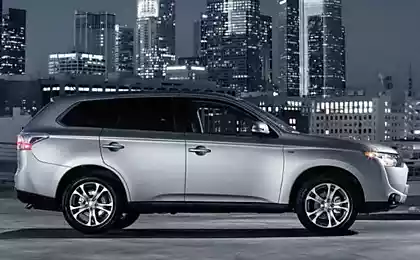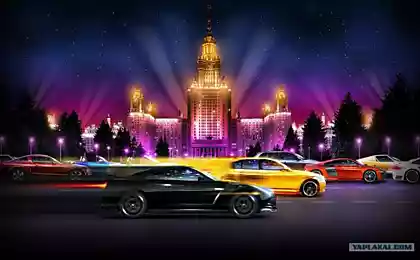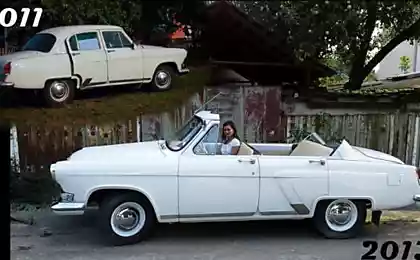878
The world's first crossover
"Morning dispelled the thick veil of mist still hung over the village. With the smell of plowed fields, pulled black soil and gasoline. Collective farmers drawn to the stable in storage. The driver started the engine of its own collective farm machinery and overtaking carts and cyclists left in the field. Came the next day, "- the first crossover in the world was not created for the urban jungle, and it is for this landscape. And this machine is not a foreign AMC Eagle, as many believe, but the Soviet GAZ-M72, and "Moskvich-410".
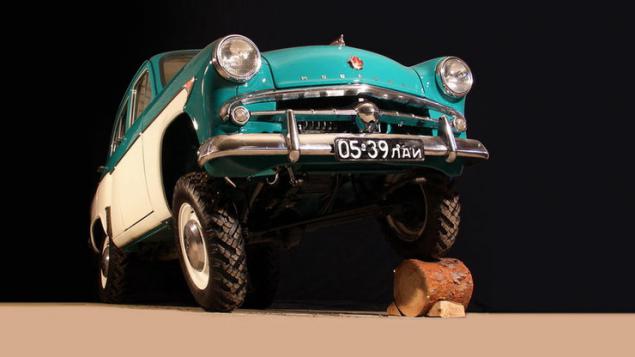
The former Soviet Union before the end of the nineties, the phrase "all wheel drive" meant only the Ulyanovsk "goat" and Tolyatti "Niva". But then we began to appear en masse hitherto unseen cars: Toyota RAV4, Honda CR-V. In everyday life caught a new word "crossover" - a cross between a passenger car and the usual kondovy SUV. In the garage after a missed cup about a new kind of cars they started talking: "That may be the same! That is able to back! ". But Soviet engineers "would know how to and" long before the new-fangled "Japanese» ...
Crossover (from Eng. Crossover - a transitional phenomenon, link) today called built on "passenger" platforms cars, which occupy an intermediate between SUVs and cars. But such features as a high ground clearance and four-wheel drive, optional steel, making Peugeot and Kia also called the models 3008 and Soul crossovers
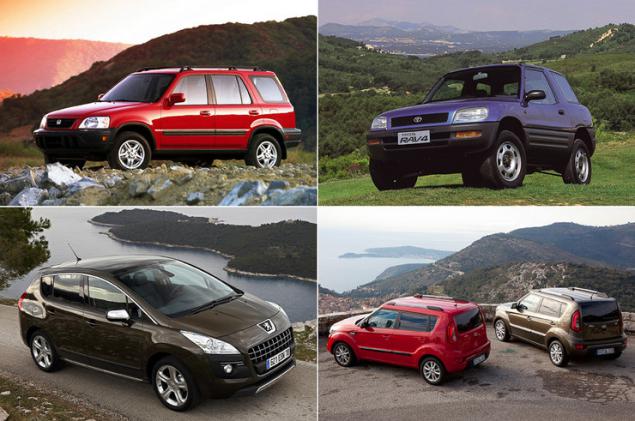
Ideas to cross passenger car and SUV occurred even during the Second World War. Similar experiments have been and German, and American and Soviet producers, the latter albeit small, but still lots produced such machines. In 1940 it started the production of GAZ-61 (this machine is built from a 6-cylinder "Emka" enjoyed by Marshal Zhukov, Konev and Rokossovsky) in 1949 released the VMS-110SH - familiar to members of the Presidium of the Central Committee of the CPSU (b) a limousine, but equipped with bridges and transmission from the American Dodge WC 51.
But the "sixty-first" and "one hundred and tenth" - more piece Products: first collected 238 copies, the second, including a later modification 110P - not more than a dozen. But seriously the development of the crossover, or rather "the design of the car all terrain", engaged in the mid-fifties, when Khrushchev "advised" to representatives of the automotive industry, "Make a car for the collective farmer!". After all, the collective farmers did not have four-wheel drive vehicles - the army of "eat" the majority been produced while GAZ-69.
What kind of car considered the world's first crossover? Marmon-Herrington (top left), which is referred to Americans cut off due to the frame structure. Chevrolet Suburban (top right) had all-wheel drive version. AMC Eagle (bottom), which many sources name the first crossover, appeared much later Soviet GAZ-M72, and "Moskvich-410" - in 1979
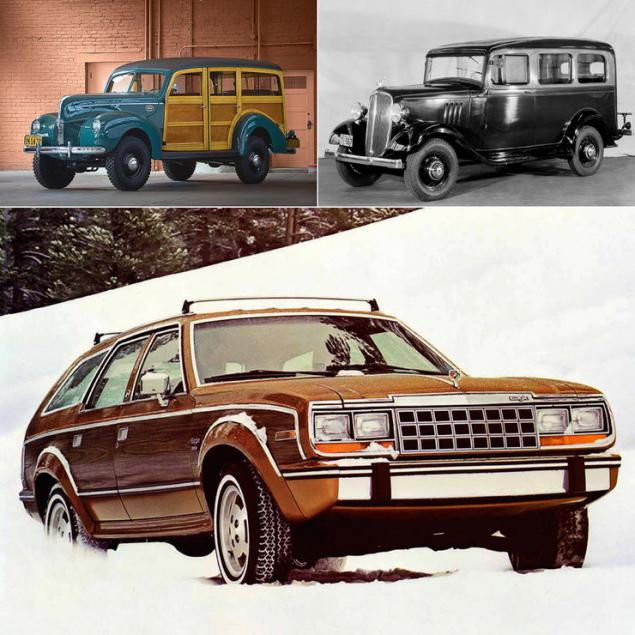
The party said: "It is necessary!»
On request, Nikita Sergeevich first right GAS - in 1955 began the production of four-wheel drive GAZ-M72, which is a hybrid body "Victory" and units Ulyanovsk "goat." Crossover? Yes! Monocoque, increased ground clearance and four-wheel drive. But "for the collective farmer" ... a new car was too comfortable. Soft pastel colored upholstery, upholstered in wool fabric sofa: in muddy boots and greasy overalls here will not climb.
Gorky engineers did not simply "rolled" under the "Victory", "truck" GAZ-69 and created a truly new car! From the "sixty-ninth" only taken razdatka and the front axle and the body "Victory" is reinforced by fourteen additional elements, and the other the sub-frame. An interesting detail: the model of the M-72 was the first Soviet car with windscreen washer.
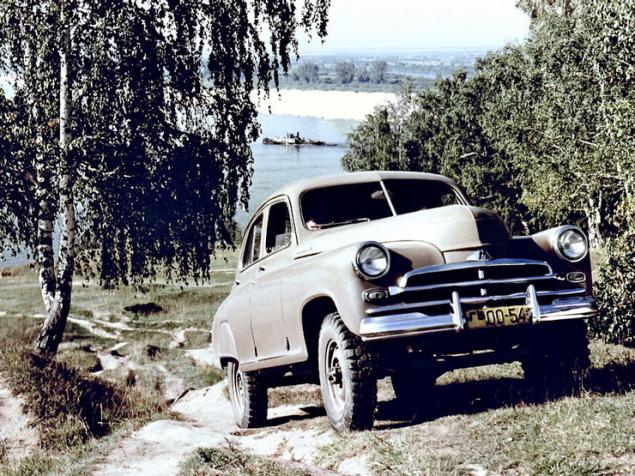
Not surprisingly, the parallel luxurious for its time, the GAZ-M72 machine was created and "easier", which received index M73. The group of designers led by Gregory Wasserman, a student of the "king of off-road vehicles," Vitaly Grachev, has designed a compact crossover without regard to other Soviet cars, but the engine and took the box "moskvichёvskie" - the model 402. From the "four hundred and second," and used the body, although a few recycled - from the four-door sedan engineers tailored practical pickup and ... coupe!
The resulting hybrid impressed testers and designers of his cross. With a length of 3430 mm (for comparison, the visual "standard" Russian motorists, "Oka", shorter by 23 cm) valiantly to overcome any obstacles that the new machine would meet in the countryside: muddy along the country road, tractor ruts plowed black earth - everything was "Seventy-third" on the shoulder. But the conveyor GAZ-M73 did not get: banal enough production capacity of the plant to put on the production of novelty.
Release of "the world's first crossover" GAZ-M72 unnoticed contemporaries: rear-wheel drive if "victory" was released on 236,000, the all-wheel drive M72 - only 4677 pieces. So it is not surprising that this model (left), as well as a prototype of the GAZ-M73 (right), unknown wide range of motorists. Meanwhile, test reports say both cars on the cross did not concede a GAZ-69!

"Moskvich" not for Muscovites
But M73 served as a good service engineers MZMA, Moscow plant of small cars (then the name wore future AZLK) - Gorky's "short stack" taken as a basis for the design of all-wheel drive version of the "Moskvich-402", which received its own index of 410. In 1957, the first " four hundred and tenth "came out of the factory gates: Drive your own designs, spring suspension and lever (!) instead of the usual shock today telescopic, reduction gear, and ground clearance of 430 mm at the bottom. Complete all-terrain vehicle!
Engine "four hundred tenth" gave just 35 hp! Lack of power engineers are compensated for lightweight machines, as well as a good selection of the size of the wheels and gear ratios in the transmission. After upgrading the 1958 model received the body from the "Moskvich-407", 45-horsepower engine, 4-speed gearbox instead of the 3-step and was named 410N
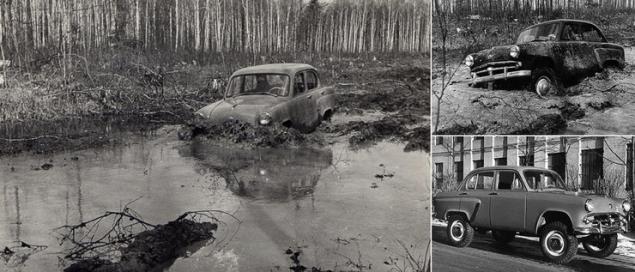
But the car turned awkwardness. Take filing magazines "Behind the wheel" of the Soviet period and see how many letters in the respected publication readers wrote about the all-wheel drive "Moskvich". V. Tymoshenko from the Krasnodar region was interested in, "Can I remove the increased vybratsiyu?". B. acorns from Orsha asked: "Is it possible to alter the" Moskvich-410 "to" Moskvich-407 "?". And there are complaints in which motorists Soviet Union tried to find answers to questions relating to the design of the machine, - big set ...
Why do consumers were dissatisfied with the car? The most important shortcomings - in side banks "Moskvich" is easily tipped over, and the body turned out to be insufficiently tough: spars burst, racks warp ... The weakness of the design tried to eliminate in an unusual way - instead of the sedan type designers MZMA used structurally more rigid five-door body on the model 423. However, in the early sixties of the release wheel drive "Muscovites" refused. The official reason - liberating power plant for production of export models.
This post is the last one.
Source: mail.ru
From 1957 to 1960 it was released 11 890 all-wheel drive "Muscovites", including 411 station wagon (bottom left) and the upgraded sedan 410N (bottom right). Some cars written off after overturning (as is often the case with the "four hundred and tenth"), the other part of the "self-destruct" - body cracked and rusted. So today preserved "Moskvich-410" - a rarity
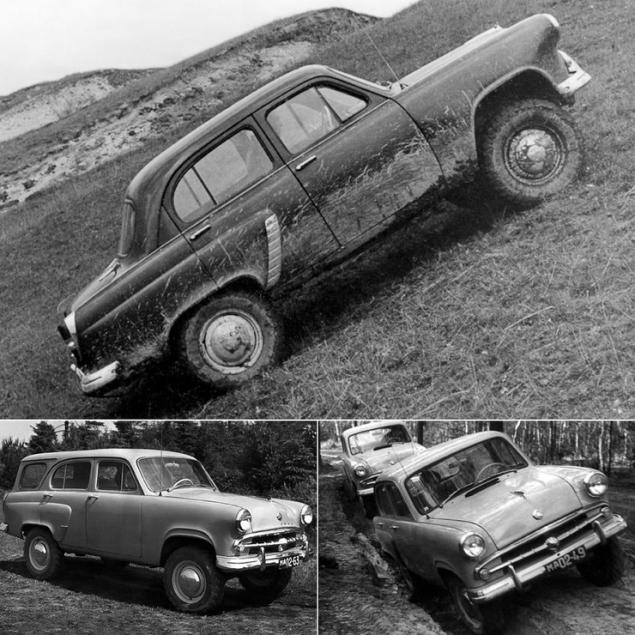
Source:

The former Soviet Union before the end of the nineties, the phrase "all wheel drive" meant only the Ulyanovsk "goat" and Tolyatti "Niva". But then we began to appear en masse hitherto unseen cars: Toyota RAV4, Honda CR-V. In everyday life caught a new word "crossover" - a cross between a passenger car and the usual kondovy SUV. In the garage after a missed cup about a new kind of cars they started talking: "That may be the same! That is able to back! ". But Soviet engineers "would know how to and" long before the new-fangled "Japanese» ...
Crossover (from Eng. Crossover - a transitional phenomenon, link) today called built on "passenger" platforms cars, which occupy an intermediate between SUVs and cars. But such features as a high ground clearance and four-wheel drive, optional steel, making Peugeot and Kia also called the models 3008 and Soul crossovers

Ideas to cross passenger car and SUV occurred even during the Second World War. Similar experiments have been and German, and American and Soviet producers, the latter albeit small, but still lots produced such machines. In 1940 it started the production of GAZ-61 (this machine is built from a 6-cylinder "Emka" enjoyed by Marshal Zhukov, Konev and Rokossovsky) in 1949 released the VMS-110SH - familiar to members of the Presidium of the Central Committee of the CPSU (b) a limousine, but equipped with bridges and transmission from the American Dodge WC 51.
But the "sixty-first" and "one hundred and tenth" - more piece Products: first collected 238 copies, the second, including a later modification 110P - not more than a dozen. But seriously the development of the crossover, or rather "the design of the car all terrain", engaged in the mid-fifties, when Khrushchev "advised" to representatives of the automotive industry, "Make a car for the collective farmer!". After all, the collective farmers did not have four-wheel drive vehicles - the army of "eat" the majority been produced while GAZ-69.
What kind of car considered the world's first crossover? Marmon-Herrington (top left), which is referred to Americans cut off due to the frame structure. Chevrolet Suburban (top right) had all-wheel drive version. AMC Eagle (bottom), which many sources name the first crossover, appeared much later Soviet GAZ-M72, and "Moskvich-410" - in 1979

The party said: "It is necessary!»
On request, Nikita Sergeevich first right GAS - in 1955 began the production of four-wheel drive GAZ-M72, which is a hybrid body "Victory" and units Ulyanovsk "goat." Crossover? Yes! Monocoque, increased ground clearance and four-wheel drive. But "for the collective farmer" ... a new car was too comfortable. Soft pastel colored upholstery, upholstered in wool fabric sofa: in muddy boots and greasy overalls here will not climb.
Gorky engineers did not simply "rolled" under the "Victory", "truck" GAZ-69 and created a truly new car! From the "sixty-ninth" only taken razdatka and the front axle and the body "Victory" is reinforced by fourteen additional elements, and the other the sub-frame. An interesting detail: the model of the M-72 was the first Soviet car with windscreen washer.

Not surprisingly, the parallel luxurious for its time, the GAZ-M72 machine was created and "easier", which received index M73. The group of designers led by Gregory Wasserman, a student of the "king of off-road vehicles," Vitaly Grachev, has designed a compact crossover without regard to other Soviet cars, but the engine and took the box "moskvichёvskie" - the model 402. From the "four hundred and second," and used the body, although a few recycled - from the four-door sedan engineers tailored practical pickup and ... coupe!
The resulting hybrid impressed testers and designers of his cross. With a length of 3430 mm (for comparison, the visual "standard" Russian motorists, "Oka", shorter by 23 cm) valiantly to overcome any obstacles that the new machine would meet in the countryside: muddy along the country road, tractor ruts plowed black earth - everything was "Seventy-third" on the shoulder. But the conveyor GAZ-M73 did not get: banal enough production capacity of the plant to put on the production of novelty.
Release of "the world's first crossover" GAZ-M72 unnoticed contemporaries: rear-wheel drive if "victory" was released on 236,000, the all-wheel drive M72 - only 4677 pieces. So it is not surprising that this model (left), as well as a prototype of the GAZ-M73 (right), unknown wide range of motorists. Meanwhile, test reports say both cars on the cross did not concede a GAZ-69!

"Moskvich" not for Muscovites
But M73 served as a good service engineers MZMA, Moscow plant of small cars (then the name wore future AZLK) - Gorky's "short stack" taken as a basis for the design of all-wheel drive version of the "Moskvich-402", which received its own index of 410. In 1957, the first " four hundred and tenth "came out of the factory gates: Drive your own designs, spring suspension and lever (!) instead of the usual shock today telescopic, reduction gear, and ground clearance of 430 mm at the bottom. Complete all-terrain vehicle!
Engine "four hundred tenth" gave just 35 hp! Lack of power engineers are compensated for lightweight machines, as well as a good selection of the size of the wheels and gear ratios in the transmission. After upgrading the 1958 model received the body from the "Moskvich-407", 45-horsepower engine, 4-speed gearbox instead of the 3-step and was named 410N

But the car turned awkwardness. Take filing magazines "Behind the wheel" of the Soviet period and see how many letters in the respected publication readers wrote about the all-wheel drive "Moskvich". V. Tymoshenko from the Krasnodar region was interested in, "Can I remove the increased vybratsiyu?". B. acorns from Orsha asked: "Is it possible to alter the" Moskvich-410 "to" Moskvich-407 "?". And there are complaints in which motorists Soviet Union tried to find answers to questions relating to the design of the machine, - big set ...
Why do consumers were dissatisfied with the car? The most important shortcomings - in side banks "Moskvich" is easily tipped over, and the body turned out to be insufficiently tough: spars burst, racks warp ... The weakness of the design tried to eliminate in an unusual way - instead of the sedan type designers MZMA used structurally more rigid five-door body on the model 423. However, in the early sixties of the release wheel drive "Muscovites" refused. The official reason - liberating power plant for production of export models.
This post is the last one.
Source: mail.ru
From 1957 to 1960 it was released 11 890 all-wheel drive "Muscovites", including 411 station wagon (bottom left) and the upgraded sedan 410N (bottom right). Some cars written off after overturning (as is often the case with the "four hundred and tenth"), the other part of the "self-destruct" - body cracked and rusted. So today preserved "Moskvich-410" - a rarity

Source:

